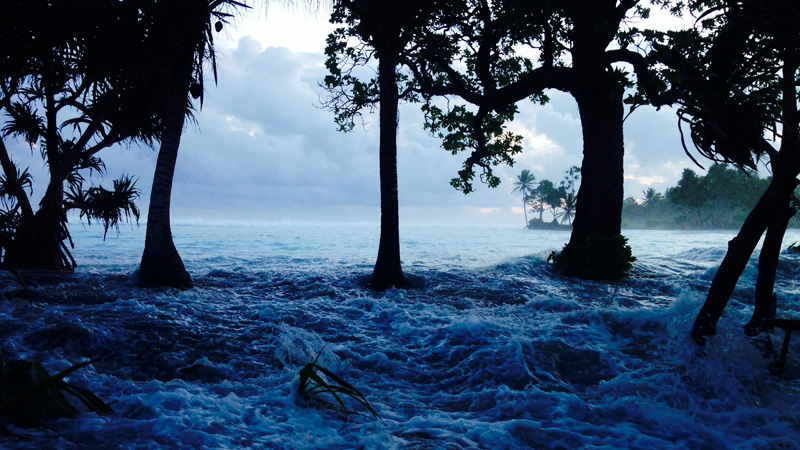A house by the sea
Imagine you live in a house close by the beach. The noise of the breaking swell, seagulls in the air and the salty taste of the ocean breeze will accompany you every day. Sounds great? Off course it does, at least one reason why 80% of the human population lives close by the ocean side. But the dream of a place by the sea is turning into a nightmare: a rising sea level is eating up the shorelines, causing soil salination and squeezing out the freshwater lenses of islands or low lying coasts.

I didn’t thought too much about all of this until I got a job at “Waan Aelon in Majel – Canoes of the Marshall Islands” about green shipping in Majuro, Marshall Islands. The Marshall Islands are a small island nation in the central Pacific between Hawai’i and Papua New Guinea. The country consists of low lying coral atolls only with the highest elevation a few meters above sea level. Short after arriving in Majuro, the capital of Marshall Island, I found the most beautiful islands I could have dreamed of, settled by wonderful gold-hearted people. But at the same time the Marshall Islands are a cumulation of almost every problem humanity caused worldwide so far: cultural damage by colonization and Americanization, drug abuse, high radiation level by nuclear weapons, overpopulation, urbanization, plastic trash, deforestation, overfishing, coral bleach, (water) pollution and the most dangerous to a low island: sea-level rise (by climate change). Most of these problems are not caused by the Marshallese people, but they are suffering. The scientist’s predictions don’t sound very promising: a couple of decades, or half a century until the islands will be uninhabitable due to the rising sea level! The population will be forced to leave their ancestors homeland – a cultural genocide.
So all hope is lost?
Not yet. The small NGO “Waan Aelon in Majel” (WAM) copy the upcoming challenges since 30 years by preserving native culture (especially boat building and sailing), offers a perspective for young people to make a living and creating awareness for the climate crisis.

As a child of the East-Frisian island Norderney I know the oppressive feeling of being surrounded by roaring waters during the storm season in winter since I can remember. But still, it was the work of and for WAM which was an eye-opener for me. Norderney and her 6 sister islands consist of fine white sand only and elevate a couple of meters above the north sea. Without any protection around they are as vulnerable for erosion as a sandcastle.
Back in Germany the daily routine and all projects I previously had been involved felt pointless compared to the real challenges of our future. Step by step the idea of combining what I’m good at (building boats and sailing) and the desire to be a part of the solution shaped out of the fog. Christian came back to Germany a couple of months later (he worked for WAM in Majuro, too) and was immediately hooked by the idea: Proasis was born.
Our fight
Every island and every shore in the world shares the same ocean with each other and is already affected by the rising sea level. Its a fight for the island I call home, for the land of our Marshallese friends and for the far majority of the human population. We can only fight (and maybe still win) it together!
The Proasis project will carry the spirit of WAM from the Pacific Ocean to new, somewhat colder waters around northern Europe. To create awareness and demonstrate an alternative way we will design, construct and sail Proasis, a pacific based proa (outrigger sailboat, see “What is a proa“). Proasis will be powered fossil-free, simple and low cost. By using mainly recycled or degradable materials she will be eco-friendly with a small footprint.
Our goal is to be visible on the water as an eye-opener for as many people as possible, in the same way, WAM has been an eye-opener to us.
